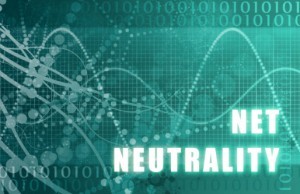Do not let the FCC’s likely unlawful means of broadband Internet regulation, i.e. Title II, distract you from the additional likelihood that two primary ends of supposed net neutrality “policy canon” i.e. bans against “paid prioritization” and “two-sided markets” (only users should pay), are also likely unlawful, even under Title II, sans new legislation.
A preview of oral arguments December 4 before the D.C. Circuit Court of Appeals in the legal challenge to the FCC’s 2015 Open Internet Order warrants more than the already well-covered standard comparison of both sides legal arguments over the legality of Title II.
In the 2014 Verizon v. FCC decision, that overturned much of the FCC’s net neutrality “effort to compel broadband providers to treat all Internet traffic the same regardless of source,” Judge David Tatel’s starting point was what does the FCC want to compel from others and does it have the legal authority and latitude to do so – sans new legislation.
(This analysis assumes the near obvious that Judge Tatel will lead and write this decision.)
If Judge Tatel approaches the starting point of this case, consistent with his net neutrality starting point in his Verizon v. FCC decision, it is highly problematic for the FCC. That is because what the FCC explicitly wants to do at core with net neutrality is still likely unlawful —even under Title II.
I believe the conventional wisdom of net neutrality activists — that Title II gives the FCC sufficient authority to ban “paid prioritization” and “two-sided markets” — may be “politically correct,” but not legally correct..
Why is net neutrality activists’ Title II conventional wisdom wrong?
First, an FCC ban on “paid prioritization,” aka “zero pricing,” unreasonably mandates a permanent price of zero for all downstream Internet traffic from the edge to an ISP with no ISP cost recovery for the traffic delivery service.
While Title II could give the FCC “reasonable” pricing authority, FCC and other utility tariff case precedents have long established what is “reasonable” under common carrier regulation.
The government compelling a regulated entity to provide a service free, with no cost recovery is not something tariff precedents have found “reasonable.” (See George Ford’s and Larry Spiwak’s Phoenix Center paper: here.)
Second, an FCC Title II ban against a “two-sided market” for Internet service is an arbitrary/unreasonable classification/treatment of similarly situated services when Title II has long embraced two-sided markets with collect and 1-800 calls, yellow pages advertising, etc.
Economically, bans on payment for downstream Internet traffic and a two-sided market, combine to compel a particular economic business model/entitlement that arbitrarily and politically redistributes and socially engineers the Internet’s economic costs and benefits between edge providers and users. (See paper by net neutrality activist Tim Wu entitled: “Subsidizing Creativity Through Network Design: Zero Pricing and Net Neutrality.”)
What does the FCC’s process tells us about the order’s biggest legal problems?
Here is an important assumption in my analysis.
Since Chairman Wheeler is not trained as a lawyer like his predecessors have been, I assume he has relied heavily on the legal judgment of the FCC’s General Counsel Jonathan Sallet, the Chairman’s senior staff lawyers and the bureaus’ best staff lawyers to determine the FCC’s best legal strategy to win in court.
Thus, it is telling and important to remember that the FCC’s best legal talent recommended against pursuing a Title II legal strategy to bolster the legal viability of the current Open Internet Order upon appeal.
The FCC’s legal staff recommended following Judge Tatel’s gift-wrapped, legal guide inVerizon v. FCC to the letter in order to uphold the FCC’s net neutrality authority under its newly-minted positive Section 706 authority.
Chairman Wheeler and his legal team chose to take the proverbial bird in hand over chasing the [Title] two birds in the bush.
It was a wise approach in that the FCC very likely could have secured roughly 75% of the practical authority it sought, but importantly could not deliver what net neutrality activists apparently most wanted – the bans on paid prioritization and two-sided markets — that I spotlighted above.
Simply, net neutrality activists politically pushed the FCC Chairman and his legal staff to go legally where they did not want to go, on both the NPRM in May 2014 and in the final order in 2015.
They even got the President of the United States to publicly and specifically urge for the FCC to pursue a Title II FCC legal strategy “to implement the strongest possible rules to protect net neutrality.”
The FCC’s legal team, from no fault of their own must now go before Judge Tatel with a third attempt to implement the FCC’s net neutrality policy, by effectively biting the hand that fed them a viable legal strategy to avoid losing in court a third time in a row for serially overreaching.
The legal risk that outside political forces thrust on the FCC’s legal team only got worse just a week before the FCC’s February 2015 vote on the order.
A lavishingly-self-serving and FCC-torpedo-ing February 20, 2015 Google ex parte (followed by apparent White House lobbying) effectively took net neutrality activists legal bullying of the FCC’s legal team to yet another appalling level of outside interference with a supposed independent agency.
Google asked for, and ultimately got in the FCC Open Internet Order, that the FCC not classify the service between a broadband provider and an edge provider like Google as a Title II carrier service.
Google went so far in its ex parte, to urge the FCC to challenge Judge Tatel’s gift in Verizon v. FCC by asserting Judge Tatel’s core analysis of how common carrier services work in Verizon v. FCC created an “imagined edge provider access service“… “a non-existent edge provider service“… and “without reference to any evidence, that “broadband providers furnish a service to edge providers”…”
Conclusion
In throwing their White House political weight around to get the FCC to do what the FCC’s legal team did not think was ultimately lawful, net neutrality pressure groups, Google and the Internet Association put a blinking neon spotlight on what they thought was necessary to achieve their net neutrality ideal.
However, two times already, in Comcast v. FCC in 2010 and in Verizon v. FCC in 2014, the D.C. Circuit Court of Appeals ruled the FCC overreached its existing authority to enforce so-called “net neutrality.”
The point of this preview before the oral arguments is for people to look for how the presiding D.C. Circuit Appeals Court Judges: David Tatel, Stephen Williams, and Sri Srinivasan, think about the new core net neutrality canon (bans on paid prioritization and two-sided markets) that net neutrality activists now covet and the Verizon Court had the most trouble with.
Those are the most likely proverbial irresistible forces meeting the immovable objects.
These two unreasonable commercial behavior net neutrality bans, in addition to the FCC ignoring Congress’ double immunity of wireless broadband from common carrier regulation, is where the FCC is most reliably vulnerable.
There are also many other ways the FCC could have serious legal problems with this albatross of an order.
My core takeaway here is that after oral arguments, reasonable net neutrality activists should have more interest in seeking a legislative net neutrality solution in Congress soonest, because their net neutrality ideal is at substantial risk when Judge Tatel’s likely decision comes down in roughly the March 2016 timeframe.
[Originally published at Precursor Blog]
Scott Cleland served as Deputy U.S. Coordinator for International Communications & Information Policy in the George H. W. Bush Administration. He is President of Precursor LLC, a research consultancy for Fortune 500 companies, and Chairman of NetCompetition, a pro-competition e-forum supported by broadband interests.





